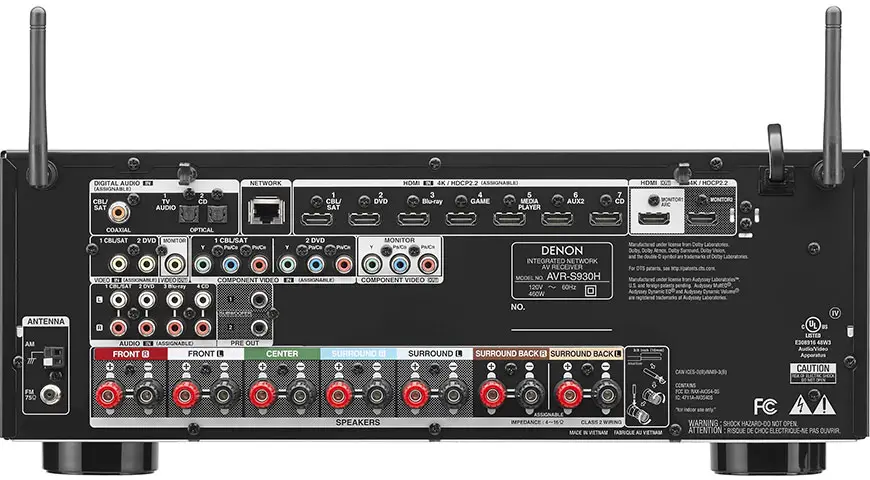It’s interesting to see the changes each time a new AVR is released. I jumped at the chance to review the Denon AVR-S930H, one of the more advanced models put out in quite a while. Yes, it’s still in a black box that resembles nearly every other unit, past or present. It’s what’s been done to improve audio and visual playback, such as Dolby Atmos and Dolby Vision, that piqued my interest. Could a 7.2 channel unit under $600 really live up to the hype?

About the AVR-S930H
Sound is one of the first things that establishes an AVR’s credibility, especially when it’s equipped with DTS:X object-based surround sound, standard surround sound, and Dolby Atmos. The Denon AVR-S930H did not disappoint when I put it to the test, even when using an average speaker system. Streaming music is a simple task using HEOS wireless multiroom connectivity. High resolution audio up to 5.6 MHz is supported and provides streaming of favorites like Pandora, Tidal, and Spotify. Bluetooth, AirPlay, and dual-band Wi-Fi are built-in. The HEOS app is uncomplicated and very responsive.
Get impressive power with Eco Mode and the 7-channel Discrete Amplifier. The Auto Eco mode of the Denon AVR-S930H adjusts volume level. Denon’s also provided an Eco meter on-screen that displays real time power consumption reduction. The unit’s low impedance drive capability provides operational stability with a large assortment of compatible 4-ohm speakers.
Denon AVR-S930H has 8 HDMI inputs (one in front) and dual HDMI outputs. It supports HDCP 2.2, allowing passthrough of 4K Ultra HD content with HDR such as Dolby Vision. Next-generation video and audio features produce an ideal home entertainment system. DTS:X 3D and Dolby Atmos sound decoders create a home theater audio that supports video technology like:
- HDR.
- 4K Scaling.
- Dolby Vision.
Below is the back panel layout. Click on image to enlarge for a clearer view.

Denon AVR-S930H Back Panel
Comparison Between Denon AVR-S930H and Onkyo TX-NR676
The Onkyo TX-NR676 boasts the same price range and many of the features found in Denon’s AVR-S930H. Buttons on the front of the NR676 serve as a backup remote controller in case the traditional one is misplaced, controlling features like input select, volume, and tone. It didn’t take long for me to discover that both units are built to reinforce each company’s reputation for customer satisfaction and next-generation readiness. Onkyo’s support manual could have been more useful, but it is a minor complaint as the information is available online. The NR676 use of Dynamic Audio Amplification enhances the theater experience with its near-perfect sound reproduction.
I found the AVR-S930H’s sound quality to be impressive when compared to similar units, including the TX-NR676. Each room has its quirks, particularly when it comes to acoustics. Onkyo’s addresses this challenge with its automatic calibration system, AccuEQ. It uses a mic (included in the box) to balance and set the sound. After a few minutes of listening to audio without calibration, I plugged in the microphone and left the room until setup was done. Distance settings and front and rear crossovers delivered a positive difference in audio after calibration.
Denon’s calibration is achieved with a measuring mic and the Audyssey MultEQ automatic room acoustic correction system. The easy-to-use setup and calibration measures the home theater’s speakers and adjusts the sound to deliver natural, smooth balance. I particularly like that it works with a multitude of speakers, no matter which models and brands are used for the home theater experience. Instead of reaching for the remote to turn down annoying, noisy advertisements, Audyssey Dynamic Volume reduces the sound automatically. The Editor App is an additional option sold at GooglePlay and Apple’s Appstore. It provides more tailored sound and customization of film audio for an even better home theater experience.
As always, comparing one good unit to another results in a dilemma of which is best. In this case, choosing between the AVR-S930H and the TX-NR676 is best done by selecting additional features (such as a phono player) that will make owning the unit even more exciting.
Features
Dolby Atmos delivers an enveloping 5.1 surround sound speaker system for the AVR-S930H. Dolby Surround upmixer is included for legacy content. Maximize the home theater experience with two Dolby Atmos elevation speakers or two overhead speakers.
DTS:X creates multi-dimensional audio by its sound placement. Use it with games, movies, and music for an improved AV experience.
HDMI Video includes 8 HDMI inputs and supports features like Full 4K Ultra HD, Wide Color Gamut, and the option to run TV and a projector at the same time.
Pros
- Built-in Wi-Fi, AirPlay, and Bluetooth
- Easy setup
- Several remote control options
Cons
- Limited upgrades from the previous model
Conclusion
The Denon AVR-S930H is a low-cost way to upgrade the home theater experience that’s next-generation ready to perform. Its additional features make it a good investment as a first or even second AVR. Sound quality is enhanced through calibration and options like Audyssey Multi EQ Editor App.
